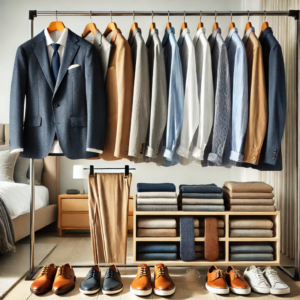In the professional world, first impressions matter. Whether you’re stepping into a corporate office, attending a networking event, or delivering a presentation, your outfit often speaks before you do. Business attire is more than just clothing—it’s a tool that communicates professionalism, confidence, and respect. Here’s a guide to help you navigate the nuances of dressing for success in the modern workplace.
Table of Contents
ToggleUnderstanding Business Attire

In the professional world, your attire is often the first impression you make. Business attire is more than just dressing up—it’s a visual representation of your professionalism, respect for the workplace, and understanding of company culture. But with dress codes varying across industries and companies, it’s essential to know what different types of business attire mean and when to wear them.
Types of Business Attire
Business attire generally falls into four categories, each suitable for different contexts:
Business Formal
This is the most professional tier of business attire, typically reserved for high-stakes meetings, interviews, and formal events.
Men: A dark suit (navy, charcoal, or black), a white or light-colored dress shirt, a silk tie, and polished dress shoes. Accessories like cufflinks and a leather belt add a touch of sophistication.
Women: A tailored pantsuit or skirt suit in neutral tones, paired with a blouse, closed-toe heels, and minimal jewelry.
Business Professional
Slightly less rigid than business formal but still polished and professional, this style is ideal for daily office wear in traditional industries like finance, law, or consulting.
Men: Dress pants, a button-up shirt, and a blazer, with or without a tie.
Women: A pencil skirt or tailored trousers, a blouse or sweater, and optional blazer. Subtle patterns and colors are acceptable.
Business Casual
A blend of professionalism and comfort, business casual is increasingly common in modern workplaces.
Men: Chinos or dress pants, collared shirts (like polos or button-ups), and loafers or oxfords.
Women: A blouse or knit top with dress pants or a midi skirt. Flats, loafers, or low heels are appropriate.
Smart Casual
This is the most relaxed tier, typically for creative industries or workplaces with flexible dress codes.
Men and Women: Tailored jeans or khakis, stylish blouses or shirts, and sneakers or ankle boots. Layers like cardigans or lightweight jackets add a polished touch.
Tips for Perfecting Your Business Attire

Prioritize Fit: No matter how expensive or stylish your outfit is, an ill-fitting garment can ruin the look. Invest in tailoring to ensure your clothing complements your body type.
Choose Quality Fabrics: Durable and breathable fabrics like wool, cotton, and silk not only look better but also last longer.
Mind the Details: Well-maintained shoes, a neatly pressed outfit, and subtle accessories like a watch or a belt can make a big difference.
Adapt to the Culture: Observe your colleagues and superiors to gauge the company’s dress code. When in doubt, err on the side of being slightly overdressed.
Stay Comfortable: Confidence comes from feeling good in what you wear. Ensure your outfit allows you to move freely and doesn’t compromise on comfort.
Common Mistakes to Avoid
Over or Under-Dressing: Misjudging the dress code can lead to discomfort and negative impressions. When in doubt, err on the side of being slightly overdressed.
Neglecting Grooming: Wrinkled clothes, unkempt hair, or scuffed shoes can ruin an otherwise perfect look.
Ignoring Industry Standards: Tech startups might welcome hoodies, but a law firm likely won’t. Research the norms of your workplace or industry.
Tips for Building Your Business Wardrobe

Start with Essentials: Invest in versatile pieces like a classic blazer, neutral trousers, and crisp shirts. These can be mixed and matched to create multiple outfits.
Quality Over Quantity: It’s better to own a few high-quality items than a closet full of cheap, fast-fashion pieces that won’t last.
Experiment Gradually: Once you’ve mastered the basics, incorporate bolder colors, patterns, or accessories that align with your personal style.
Stay Comfortable: Business attire doesn’t have to be restrictive. Look for stretch fabrics and ergonomic shoe designs to keep you comfortable throughout the day.
Why Business Attire Matters
Dressing appropriately in the workplace does more than adhere to social norms. It builds credibility, fosters respect, and boosts self-confidence. When you’re dressed for success, you’re signaling that you’re serious about your work and your role within the organization.
Whether you’re starting a new job, aiming for a promotion, or simply seeking to leave a lasting impression, understanding and mastering business attire is an essential step in your professional journey.
In Conclusion
Your wardrobe is a powerful tool. By investing in versatile, high-quality pieces and understanding the nuances of business attire, you can confidently navigate any professional setting and make your mark. After all, dressing well is not just about what you wear—it’s about how you present yourself to the world.
FAQs About Business Attire
What’s the difference between business formal and business professional?
Business Formal is the most polished and traditional dress code, often required for high-stakes meetings, ceremonies, or interviews. It includes dark suits, white shirts, and conservative ties for men, and tailored suits with skirts or trousers for women.
Business Professional is slightly less rigid, suitable for day-to-day office wear in traditional industries. Men can skip the tie, and women may incorporate more variety in colors and patterns while still appearing sharp and professional.
Can I wear jeans in a business casual setting?
It depends on the company’s policy. In many workplaces, dark, tailored jeans without rips or embellishments can be acceptable as part of a business casual or smart casual outfit. However, if you’re unsure, it’s safer to opt for chinos or dress pants.
Are sneakers appropriate for business casual?
Sneakers can be appropriate in more relaxed workplaces, especially for smart casual attire. However, they should be clean, minimalist, and styled to complement your outfit. In more traditional business casual settings, loafers, oxfords, or flats are a better choice.
What colors are considered professional for business attire?
Neutral tones like navy, black, gray, beige, and white are the safest and most professional choices. For business casual or smart casual, you can experiment with muted colors (like pastels) or subtle patterns (like checks or pinstripes) to add personality without losing professionalism.
How can I dress appropriately without overspending?
Focus on building a capsule wardrobe with versatile pieces. Start with essentials like a navy blazer, tailored pants, crisp shirts, and neutral shoes. Invest in high-quality staples that can be mixed and matched, and look for sales or outlet stores to save on costs.
How do I choose the right shoes for business attire?
The choice depends on the dress code:
Business Formal/Professional: Opt for leather oxfords, loafers, or heels in black, brown, or nude.
Business Casual: Brogues, loafers, ballet flats, or ankle boots are excellent options.
Smart Casual: Clean sneakers, stylish boots, or flats work well, provided they are polished and in good condition.


